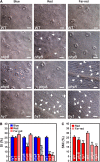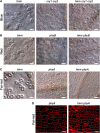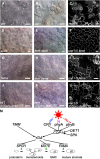Cryptochromes, phytochromes, and COP1 regulate light-controlled stomatal development in Arabidopsis
- PMID: 19794114
- PMCID: PMC2768914
- DOI: 10.1105/tpc.109.069765
Cryptochromes, phytochromes, and COP1 regulate light-controlled stomatal development in Arabidopsis
Abstract
In Arabidopsis thaliana, the cryptochrome (CRY) blue light photoreceptors and the phytochrome (phy) red/far-red light photoreceptors mediate a variety of light responses. COP1, a RING motif-containing E3 ubiquitin ligase, acts as a key repressor of photomorphogenesis. Production of stomata, which mediate gas and water vapor exchange between plants and their environment, is regulated by light and involves phyB and COP1. Here, we show that, in the loss-of-function mutants of CRY and phyB, stomatal development is inhibited under blue and red light, respectively. In the loss-of-function mutant of phyA, stomata are barely developed under far-red light. Strikingly, in the loss-of-function mutant of either COP1 or YDA, a mitogen-activated protein kinase kinase kinase, mature stomata are developed constitutively and produced in clusters in both light and darkness. CRY, phyA, and phyB act additively to promote stomatal development. COP1 acts genetically downstream of CRY, phyA, and phyB and in parallel with the leucine-rich repeat receptor-like protein TOO MANY MOUTHS but upstream of YDA and the three basic helix-loop-helix proteins SPEECHLESS, MUTE, and FAMA, respectively. These findings suggest that light-controlled stomatal development is likely mediated through a crosstalk between the cryptochrome-phytochrome-COP1 signaling system and the mitogen-activated protein kinase signaling pathway.
Figures









Comment in
-
Integration of signaling pathways in stomatal development.Plant Cell. 2009 Sep;21(9):2542. doi: 10.1105/tpc.109.210910. Epub 2009 Sep 30. Plant Cell. 2009. PMID: 19794117 Free PMC article. No abstract available.
Similar articles
-
Phytochrome B is involved in mediating red light-induced stomatal opening in Arabidopsis thaliana.Mol Plant. 2010 Jan;3(1):246-59. doi: 10.1093/mp/ssp097. Epub 2009 Nov 24. Mol Plant. 2010. PMID: 19965572
-
Red-light-dependent interaction of phyB with SPA1 promotes COP1-SPA1 dissociation and photomorphogenic development in Arabidopsis.Mol Plant. 2015 Mar;8(3):467-78. doi: 10.1016/j.molp.2014.11.025. Epub 2014 Dec 30. Mol Plant. 2015. PMID: 25744387
-
Jasmonic acid enhancement of anthocyanin accumulation is dependent on phytochrome A signaling pathway under far-red light in Arabidopsis.Biochem Biophys Res Commun. 2014 Nov 7;454(1):78-83. doi: 10.1016/j.bbrc.2014.10.059. Epub 2014 Oct 18. Biochem Biophys Res Commun. 2014. PMID: 25450360
-
Photoreceptor-mediated regulation of the COP1/SPA E3 ubiquitin ligase.Curr Opin Plant Biol. 2018 Oct;45(Pt A):18-25. doi: 10.1016/j.pbi.2018.04.018. Epub 2018 May 15. Curr Opin Plant Biol. 2018. PMID: 29775763 Review.
-
Regulation of Plant Photoresponses by Protein Kinase Activity of Phytochrome A.Int J Mol Sci. 2023 Jan 20;24(3):2110. doi: 10.3390/ijms24032110. Int J Mol Sci. 2023. PMID: 36768431 Free PMC article. Review.
Cited by
-
Spatially patterned hydrogen peroxide orchestrates stomatal development in Arabidopsis.Nat Commun. 2022 Aug 26;13(1):5040. doi: 10.1038/s41467-022-32770-7. Nat Commun. 2022. PMID: 36028510 Free PMC article.
-
Integration of light and ABA signaling pathways to combat drought stress in plants.Plant Cell Rep. 2023 May;42(5):829-841. doi: 10.1007/s00299-023-02999-7. Epub 2023 Mar 12. Plant Cell Rep. 2023. PMID: 36906730 Review.
-
Overexpression of a SDD1-Like Gene From Wild Tomato Decreases Stomatal Density and Enhances Dehydration Avoidance in Arabidopsis and Cultivated Tomato.Front Plant Sci. 2018 Jul 4;9:940. doi: 10.3389/fpls.2018.00940. eCollection 2018. Front Plant Sci. 2018. PMID: 30022991 Free PMC article.
-
The Arabidopsis ANGUSTIFOLIA3-YODA Gene Cascade Induces Anthocyanin Accumulation by Regulating Sucrose Levels.Front Plant Sci. 2016 Nov 22;7:1728. doi: 10.3389/fpls.2016.01728. eCollection 2016. Front Plant Sci. 2016. PMID: 27920784 Free PMC article.
-
The Cryptochrome Blue Light Receptors.Arabidopsis Book. 2010 Sep 23;8:e0135. doi: 10.1199/tab.0135. Arabidopsis Book. 2010. PMID: 21841916 Free PMC article.
References
-
- Al-Sady, B., Ni, W., Kircher, S., Schäfer, E., and Quail, P.H. (2006). Photoactivated phytochrome induces rapid PIF3 phosphorylation prior to proteasome-mediated degradation. Mol. Cell 23 439–446. - PubMed
-
- Assmann, S.M., and Wang, X.Q. (2001). From milliseconds to millions of years: Guard cells and environmental responses. Curr. Opin. Plant Biol. 4 421–428. - PubMed
-
- Benvenuto, G., Formiggini, F., Laflamme, P., Malakhov, M., and Bowler, C. (2002). The photomorphogenesis regulator DET1 binds the amino-terminal tail of histone H2B in a nucleosome context. Curr. Biol. 12 1529–1534. - PubMed
Publication types
MeSH terms
Substances
LinkOut - more resources
Full Text Sources
Other Literature Sources
Molecular Biology Databases

